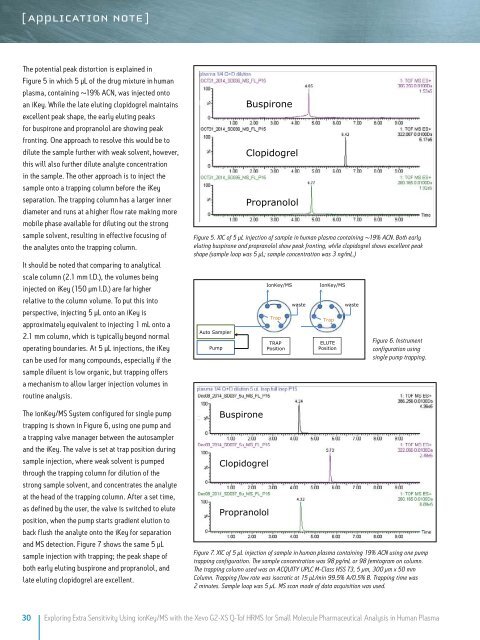ionkey/MS
1TDCbKs
1TDCbKs
Create successful ePaper yourself
Turn your PDF publications into a flip-book with our unique Google optimized e-Paper software.
The potential peak distortion is explained in<br />
Figure 5 in which 5 µL of the drug mixture in human<br />
plasma, containing ~19% ACN, was injected onto<br />
an iKey. While the late eluting clopidogrel maintains<br />
excellent peak shape, the early eluting peaks<br />
for buspirone and propranolol are showing peak<br />
fronting. One approach to resolve this would be to<br />
dilute the sample further with weak solvent, however,<br />
this will also further dilute analyte concentration<br />
in the sample. The other approach is to inject the<br />
sample onto a trapping column before the iKey<br />
separation. The trapping column has a larger inner<br />
diameter and runs at a higher flow rate making more<br />
mobile phase available for diluting out the strong<br />
sample solvent, resulting in effective focusing of<br />
the analytes onto the trapping column.<br />
It should be noted that comparing to analytical<br />
scale column (2.1 mm I.D.), the volumes being<br />
injected on iKey (150 µm I.D.) are far higher<br />
relative to the column volume. To put this into<br />
perspective, injecting 5 µL onto an iKey is<br />
approximately equivalent to injecting 1 mL onto a<br />
2.1 mm column, which is typically beyond normal<br />
operating boundaries. At 5 µL injections, the iKey<br />
can be used for many compounds, especially if the<br />
sample diluent is low organic, but trapping offers<br />
a mechanism to allow larger injection volumes in<br />
routine analysis.<br />
The ionKey/<strong>MS</strong> System configured for single pump<br />
trapping is shown in Figure 6, using one pump and<br />
a trapping valve manager between the autosampler<br />
and the iKey. The valve is set at trap position during<br />
sample injection, where weak solvent is pumped<br />
through the trapping column for dilution of the<br />
strong sample solvent, and concentrates the analyte<br />
at the head of the trapping column. After a set time,<br />
as defined by the user, the valve is switched to elute<br />
position, when the pump starts gradient elution to<br />
back flush the analyte onto the iKey for separation<br />
and <strong>MS</strong> detection. Figure 7 shows the same 5 µL<br />
sample injection with trapping; the peak shape of<br />
both early eluting buspirone and propranolol, and<br />
late eluting clopidogrel are excellent.<br />
Buspirone<br />
Clopidogrel<br />
Propranolol<br />
Figure 5. XIC of 5 µL injection of sample in human plasma containing ~19% ACN. Both early<br />
eluting buspirone and propranolol show peak fronting, while clopidogrel shows excellent peak<br />
shape (sample loop was 5 µL; sample concentration was 3 ng/mL.)<br />
Auto Sampler<br />
Pump<br />
Buspirone<br />
Clopidogrel<br />
Propranolol<br />
IonKey/<strong>MS</strong><br />
Trap<br />
TRAP<br />
Position<br />
waste<br />
IonKey/<strong>MS</strong><br />
Figure 6. Instrument<br />
configuration using<br />
single pump trapping.<br />
Figure 7. XIC of 5 µL injection of sample in human plasma containing 19% ACN using one pump<br />
trapping configuration. The sample concentration was 98 pg/mL or 98 femtogram on column.<br />
The trapping column used was an ACQUITY UPLC M-Class HSS T3, 5 µm, 300 µm x 50 mm<br />
Column. Trapping flow rate was isocratic at 15 µL/min 99.5% A/0.5% B. Trapping time was<br />
2 minutes. Sample loop was 5 µL. <strong>MS</strong> scan mode of data acquisition was used.<br />
Trap<br />
ELUTE<br />
Position<br />
waste<br />
30 Exploring Extra Sensitivity Using ionKey/<strong>MS</strong> with the Xevo G2-XS Q-Tof HR<strong>MS</strong> for Small Molecule Pharmaceutical Analysis in Human Plasma


